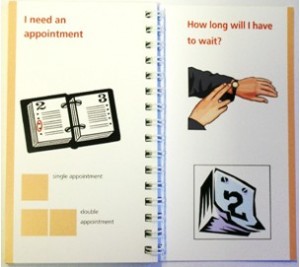Communication passports are meant to quickly and effectively communicate “need to know” information for individuals who cannot easily speak for themselves.
Download: Communication Passports
Background:  Communication passports are a useful way of supporting individuals who cannot easily speak for themselves. Passports present information in an “easy-to-follow” format that makes it possible for these individuals to get their thoughts across. The advantage of passport are that they are easy to read, informative, useful and fun.
Communication passports are a useful way of supporting individuals who cannot easily speak for themselves. Passports present information in an “easy-to-follow” format that makes it possible for these individuals to get their thoughts across. The advantage of passport are that they are easy to read, informative, useful and fun.
Population: Individuals who benefit from augmentative alternative communication (AAC), their families and service providers. This includes children and adults who struggle to or cannot communicate verbally.
- Severe language delays/disorders
- Temporary loss of communication ability, such as in hospitals.
- Experiencing dementia or gradual decrease in communication ability.
Description: A Communication Passport is a booklet of phrases and images meant to quickly and effectively communicate “need to know” information such as basic biographical, medical and personal information about an individual. Communication passports are visually interesting (colors, images, borders that stand out), simply designed, and readable (large fonts). With a well designed communication passport, it should be easy to see who the passport belongs to. Communication Passports were conceived from the question “How can information be shared effectively among many people?” The Communication Passport is meant to facilitate communication among individuals with complex communication support needs and others with whom they may interact. They were originally designed for children who have difficulty communicating verbally; however, there are now different formats which can be used with other populations, settings, and needs including adults and in hospital settings.
Communication Passports were designed based mainly on Sally Millar’s personal observations working with clients with AAC devices. She noticed a high rate of abandonment of AAC devices because they weren’t client focused. Communication passports are traditionally a 10-20 page booklet. However, a variety of different formats have been developed including a mini-pamphlet, short video and smart phone apps. Information and templates are available through the CALL Centre website. These templates can be used as guidelines, and additional personalized pictures and information should be added as necessary.
Communication Passports are…
- Visually interesting – colors, images, borders that stand out
- Simple design – not too cluttered
- Readable large font
- Should be obvious at a glance who the passport belongs to
Cost: Templates and other resources are free online. They only need to be printed and laminated.
Strengths:
- Accessible and easily understood by all.
- Highly personalized and presents the person as an individual.
- Tells newcomers how to best communicate with the individual.
- Presents most important information quickly and in one place which reduces repetition and frustration.
- Empowers individual and family.
- Can be low tech (drawn pictures) or high tech (smart phone app).
Weaknesses:
- Time consuming due to individualized nature.
- Needs to be updated as the person develops.
- Potential users must know that the child/adult has a Passport in order for it to be useful.
- Cost- free or low-cost to create
Additional Information:
There are some apps or similar variations that are recommended and available in the iTunes App Store.
- Book Creator (Free – $3.99)
- My Pictures Talk ($4.99) – video
- Pictello ($18.99)
Find other Contemporary Approaches to Intervention here!
Special thanks to Kyla Chapman, Jenna Schaeffer and Andrew Angeles.
References:
Information and templates: http://www.communicationpassports.org.uk/Home/
Well-organized guide and templates: 2014-Scope-communication-passport
Life stories: http://www.dementiauk.org/information-support/life-story-work/

![[feed link]](/wp-content/plugins/rss-just-better/rss-cube.gif)